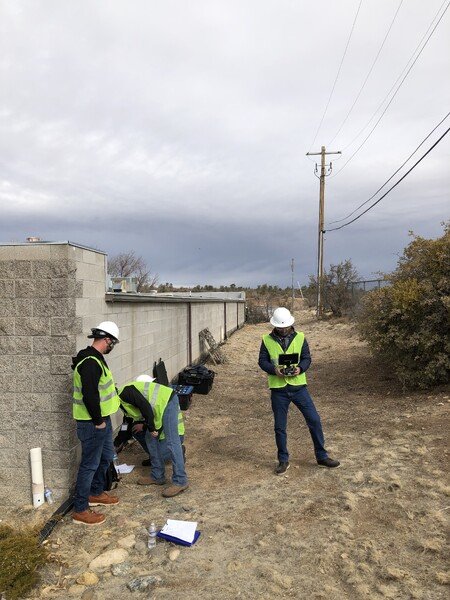Hovering Heights, Safer Flights: The New Era of Utility Line 'Bytes'
Photography by Jay Shears
Drones are revolutionizing power line inspections by providing a safer, more efficient, and cost-effective alternative to traditional methods. They can be particularly beneficial for low voltage (LV) and medium voltage (MV) inspections, due to their maneuverability and the ability to carry out inspections in areas that are difficult to access or are visually obstructed.
Small drones, for example, can navigate close to the infrastructure, reducing the need for optical zoom and minimizing potential damage in the event of an accident. During inspections, drones can capture high-quality images from multiple angles to assess the overall condition of the lines and towers, identify vegetation encroachment, and detect other issues like lightning strikes or equipment defects.
Photography by Jay Shears
One of the significant advantages of using drones is the ability to carry payloads like thermal sensors, which can detect heat emissions from power lines to analyze voltage and contact resistance. These sensors are also capable of identifying hot spots that could potentially lead to wildfires, thereby increasing the safety of the operation.
In the world of power line maintenance, drones equipped with thermal sensors are emerging as a game-changer. These sensors operate by detecting infrared radiation, revealing heat emissions from power lines. This capability is crucial for identifying 'hot spots' indicative of high resistance or overloading, commonly associated with equipment failure or wear.
Although thermal sensors don’t measure voltage directly, they suggest the possibility of electrical issues through temperature anomalies, with deviations from normal pointing to potential problems.
Photography by Jay Shears
As an example of this, the hotspots on a pole, could indicate a localized area where there is either an electrical fault, such as a failing component, or increased resistance. This could potentially be due to:
Faulty Attachments - Any equipment attached to the pole, like a transformer, fuse cutout, or other devices, could be malfunctioning or overheating.
Leaking Current - If there is a crack or damage to the insulators, it might allow some current to leak through to the pole, causing it to heat up in that area.
Conductive Contamination - The pole or its components might be contaminated with conductive materials like water or other pollutants, which could facilitate a small current flow and subsequent heating.
Vegetation Contact: If any part of the pole is in contact with vegetation, and there is a voltage potential difference, it could cause arcing or heating at the point of contact.
By analyzing these thermal images, technicians can identify areas with increased contact resistance, often due to poor connections or damaged components.
Photography by Jay Shears
A drone-assisted operation not only enhances the safety and efficiency of inspections by accessing hard-to-reach areas, but also provides real-time data for prompt analysis and action; ensuring a more reliable and safe power distribution network.
Also, the integration of advanced software systems with drones, enables real-time data processing and immediate actionable insights. This software can analyze images and video feeds, automatically detecting even the slightest changes or faults and notify relevant stakeholders in real time.
This real-time analysis is particularly valuable following adverse weather events, where drones can quickly survey the damage and provide detailed information to guide repair crews, minimizing downtime and improving service reliability.
While the use of drones realizes many 'utility line maintenence' benefits, it also comes with responsibilities; including complying with regulatory requirements to ensure safety and privacy. It's crucial to have qualified and experienced pilots - especially for Beyond Visual Line of Sight (BVLOS) operations, that'll understand and adhere to local regulations and property access privileges to gain the Public Trust.
In utility 'line maintenance', ensuring power lines are in prime condition is essential, but it comes with significant risks and expenses.
Here's a line maintenance use case when helicopters are involved. The image below shows a traditional 'live-line' operation using a helicopter. This type of mission is high-risk and very costly.
Photography by Jay Shears
👷 The Risk Factor - These operations, require skilled pilots and linemen. This line maintenance use case is amongst the most dangerous in the utility industry, due to its proximity to high-voltage lines, the public, and other challenging environments.
💰 The Cost Element - Helicopter assisted repairs come with a hefty price tag, inclusive of aviation fuel, specialized equipment, and insurance, not to mention the associated downtime costs for utilities and consumers.
Overall, the use of drones in power line maintenence offers a multitude of benefits, such as improved efficiency, increased worker safety, cost savings, and more accurate data collection. As the technology continues to advance, drones are expected to become an even more integral part of routine maintenance, and the emergency response assets used by utility companies.
A Safer, Cost-Effective Solution - Unmanned Aircraft Systems (UAS) are changing the line maintenance landscape with their efficiency and safety.
Here's how:
🤖 Efficiency - Quick deployment and precision maneuvering of UAS reduces the inspection and repair time.
🛡️ Safety - UAS minimizes the need for human proximity to high-voltage lines, thus reducing accident risks.
💸 Cost Savings - Operating UAS requires fewer resources and manpower, leading to significant savings.
📊 Data Accuracy - Advanced sensors on UAS offer repeatable and accurate detailed data.
🌱 Environmental Impact - Electric-powered UAS lower the carbon footprint of maintenance operations.
Photography by Jay Shears





